Correlation between Acoustic Analysis and Psycho-Acoustic Evaluation of Violins
Abstract
:1. Introduction
2. Materials and Methods
2.1. Materials
- reference thickness profile (corresponding to 4/4 violins, coded A00);
- thickened thickness profile, obtained by increasing the reference thickness by 0.2 mm, 0.4 mm, and 0.6 mm over the whole profile (coded AP2, AP4, and AP6, respectively);
- thinned thickness profile, obtained by decreasing the reference thickness by 0.2 mm, 0.4 mm, and 0.6 mm over the whole profile (coded AM2, AM4, and AM6, respectively).
2.2. Methods
2.2.1. The Acoustic Recording
2.2.2. The Signal Processing
2.2.3. The Psycho-Acoustical Evaluation
2.2.4. The Statistical Data Processing Method
3. Results
3.1. Results of the Acoustic Analysis
3.2. Results of the Psycho-Acoustic Analysis
4. Discussion
5. Conclusions
Author Contributions
Funding
Institutional Review Board Statement
Informed Consent Statement
Data Availability Statement
Acknowledgments
Conflicts of Interest
References
- Saitis, C.; Fritz, C.; Scavone, G.P.; Guastavino, C.; Dubois, D. Perceptual evaluation of violins: A psycholinguistic analysis of preference verbal descriptions by experienced musicians. J. Acoust. Soc. Am. 2017, 141, 2746–2757. [Google Scholar] [CrossRef] [PubMed]
- Saitis, C.; Fritz, C.; Scavone, G.P. Sounds like melted chocolate. How musicians conceptualize violin sound richness. In Proceedings of ISMA 2019, International Symposium on Music Acoustics, Detmold, Germania, 13–17 September 2019; pp. 50–57. [Google Scholar]
- Fritz, C.; Curtin, J.; Poitevineau, J.; Tao, F.-C. Listener evaluations of new and Old Italian violins. Proc. Natl. Acad. Sci. USA 2017, 114, 5395–5400. [Google Scholar] [CrossRef] [PubMed]
- Giraldo, S.; Waddell, G.; Nou, I.; Ortega, A.; Mayor, O.; Perez, A.; Williamon, A.; Ramirez, R. Automatic Assessment of Tone Quality in Violin Music Performance. Front. Psychol. 2019, 10, 334. Available online: https://www.frontiersin.org/articles/10.3389/fpsyg.2019.00334 (accessed on 15 February 2022).
- Lenssen, N.; Needell, D. An Introduction to Fourier Analysis with Applications to Music. J. Humanist. Math. 2014, 4, 72–91. Available online: http://scholarship.claremont.edu/jhm/vol4/iss1/5 (accessed on 15 February 2022). [CrossRef]
- Dünnwald, H. Deductions of objective quality parameters on old and new violins. Catgut Acoust. Soc. J. 1991, 1, 1–5. [Google Scholar]
- Campbell, M. Objective evaluation of musical instrument quality: A grand challenge in musical acoustics. In Proceedings of the Meetings on Acoustics, Montreal, QC, Canada, 2–7 June 2013. [Google Scholar]
- Letowski, T. Sound quality assessment: Concepts and criteria. In Proceedings of the 87th Convention of the Audio Engineering Society (AES), New York, NY, USA, 18–21 October 1989. [Google Scholar]
- Woodhouse, J. The acoustics of “A0-B0 mode matching” in the violin. Acust. Acta. Acust. 1998, 84, 947–956. [Google Scholar]
- Woodhouse, J. On the playability of violins. Part I Reflect. Funct. Acust. 1993, 78, 125–136. [Google Scholar]
- Gliga, V.G.; Stanciu, M.D.; Nastac, S.M.; Campean, M. Modal analysis of violin bodies with back plates made of different wood species. BioResources 2020, 15, 7687–7713. [Google Scholar] [CrossRef]
- Stanciu, M.D.; Cosereanu, C.; Dinulică, F.; Bucur, V. Effect of wood species on vibration modes of violins plates. Eur. J. Wood Prod. 2020, 78, 785–799. [Google Scholar]
- Marshall, K.D. Modal analysis of a violin. J. Acoust. Soc. Am. 1985, 77, 695–709. [Google Scholar]
- Bissinger, G. Some mechanical and acoustical consequences of the violin soundpost. J. Acoust. Soc. Am. 1995, 97, 3154. [Google Scholar] [CrossRef]
- Bissinger, G. Structural acoustics of good and bad violins. J. Acoust. Soc. Am. 2008, 124, 1764. [Google Scholar] [CrossRef] [PubMed]
- Nadarajah, M.C. The Mechanics of the Soundpost in the Violin. Ph.D. Thesis, University of Cambridge, Cambridge, UK, 2018. [Google Scholar]
- Gough, C. Acoustic characterization of string instruments by internal cavity measurements. J. Acoust. Soc. Am. 2021, 150, 1922. [Google Scholar] [CrossRef] [PubMed]
- Dinulică, F.; Albu, C.T.; Vasilescu, M.M.; Stanciu, M.D. Bark features for identifying resonance spruce standing timber. Forests 2019, 10, 799. [Google Scholar] [CrossRef]
- Mania, P.; Fabisiak, E.; Skrodzka, E. Differences in the modal and structural parameters of resonance and non-resonance wood of spruce (Picea abies). Acta Phys. Pol. A 2015, 127, 110–113. [Google Scholar]
- Stanciu, M.D.; Mihălcică, M.; Dinulică, F.; Nauncef, A.M.; Purdoiu, R.; Lăcătuș, R.; Gliga, G.V. X-ray Imaging and Computed Tomography for the Identification of Geometry and Construction Elements in the Structure of Old Violins. Materials 2021, 14, 5926. [Google Scholar] [CrossRef]
- Bucur, V. Chapter 3—Mechanical characterization of materials for string instruments. In Handbook of Materials for String Musical Instruments; Springer: Berlin, Germany, 2016; pp. 93–132. [Google Scholar]
- Hutchins, C.M. The acoustics of violin plates. Sci. Am. 1981, 245, 170–187. [Google Scholar]
- Mihălcică, M.; Stanciu, M.D.; Nastac, S.M.; Dinulică, F.; Nauncef, A.M.; Roșca, I.C.; Savin, A. Signature Modes of Old and New Violins with Symmetric Anatomical Wood Structure. Appl. Sci. 2021, 11, 11297. [Google Scholar] [CrossRef]
- Stanciu, M.D.; Dinulica, F.; Bucur, V.; Gliga, G.V.; Nastac, S.M.; Campean, M. Changing the vibrational behavior of the wooden thin arched plates—the maestro violins experimental study case. Thin-Walled Struct. 2022, 174, 109042. [Google Scholar] [CrossRef]
- Nauncef, A.M.; Mihălcică, M.; Roșca, I.C.; Gliga, G.V.; Marc, R. Interdisciplinary approach to assessing the acoustic quality of violins. Rev. Artist. Educ. 2022, 24, 330–338. [Google Scholar]
- Zacharakis, A.; Pastiadis, K.; Reiss, J.D. An interlanguage unification of musical timbre: Bridging semantic, perceptual, and acoustic dimensions. Music Percept. Interdisc. J. 2015, 32, 394–412. [Google Scholar] [CrossRef]
- Mihalcica, M.; Nauncef, A.M.; Gliga, V.G.; Nastac, S.M.; Campean, M. Correlation between dynamic features of unvarnished and varnished new violins and them acoustic perceptual evaluation. In Proceedings of the International Conference on Wave Mechanics and Vibrations (10th WMVC), Lisbon, Portugal, 4–6 July 2022. [Google Scholar]
- Shapiro, S.S.; Wilk, M.P. An analysis of variance test for normality (complete samples). Biometrika 1965, 52, 591–611. [Google Scholar] [CrossRef]
- Zar, J.H. Biostatistical Analysis; Prentice-Hall Inc.: Englewood Cliffs, UK, 1974. [Google Scholar]
- Hansen, U.J.; Rossing, T.D. Normal modes of vibration in a violin. In Proceedings of the ASA/EAA/DAGA99 Meeting, Lay Language Papers, Berlin, Germany, 16 March 1999; Volume 635. [Google Scholar]
- Pyrkosz, M.; Van Karsen, C. Comparative Modal Tests of a Violin. Exp. Tech. 2013, 37, 47–62. [Google Scholar] [CrossRef]
- Stepanek, J.; Otcenasek, Z. Acoustical correlates of the main features of violin timbre perception. In Proceedings of the Conference on Interdisciplinary Musicology, Montreal, QC, Canada, 10–12 March 2005; pp. 1–9. [Google Scholar]
- Jiang, W.; Liu, J.; Zhang, X.; Wang, S.; Jiang, Y. Analysis and Modeling of Timbre Perception Features in Musical Sounds. Appl. Sci. 2020, 10, 789. [Google Scholar] [CrossRef]
- Wei, Y.; Gan, L.; Huang, X. A Review of Research on the Neurocognition for Timbre Perception. Front. Psychol. 2022, 13, 869475. [Google Scholar] [CrossRef] [PubMed]

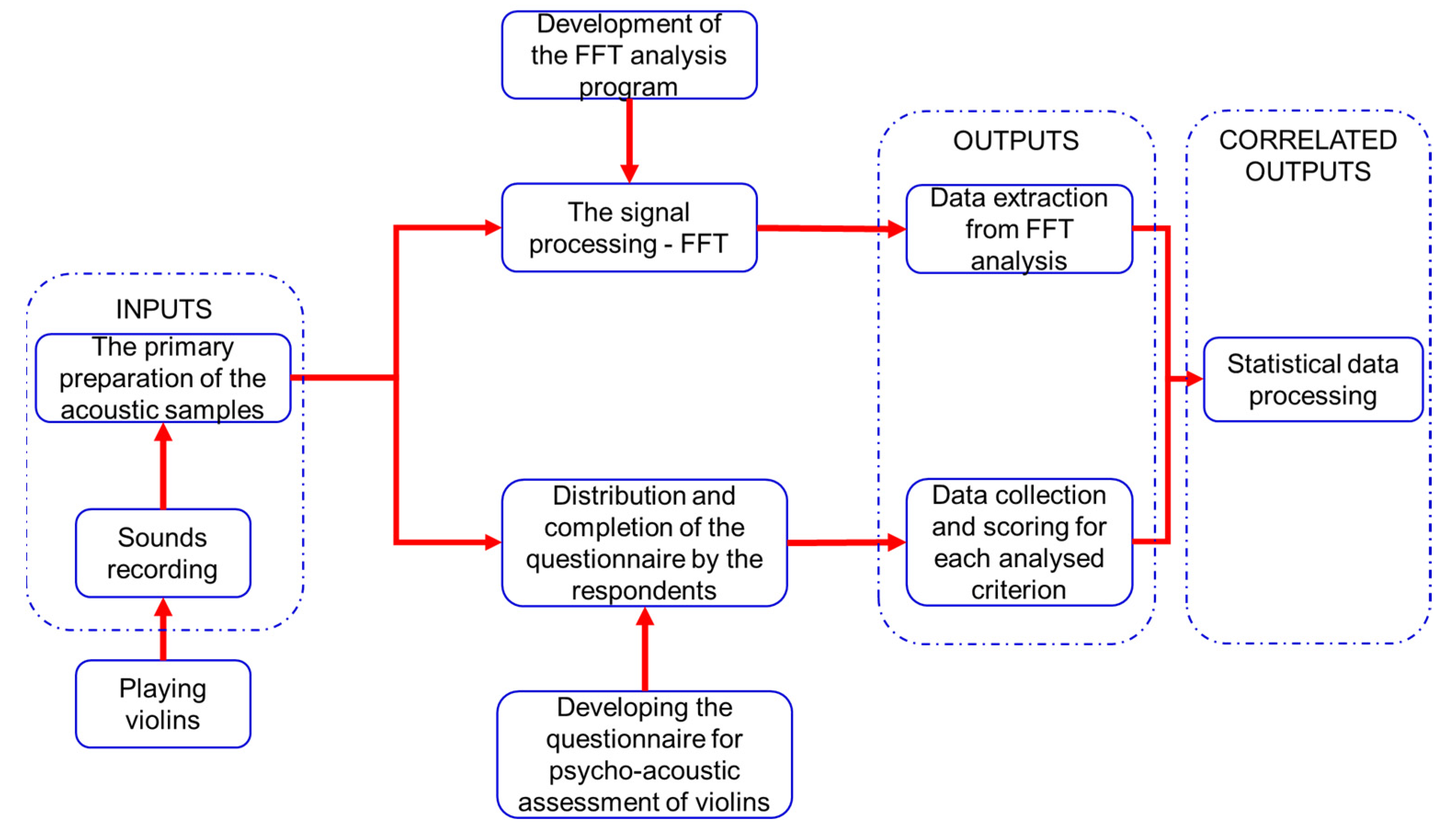


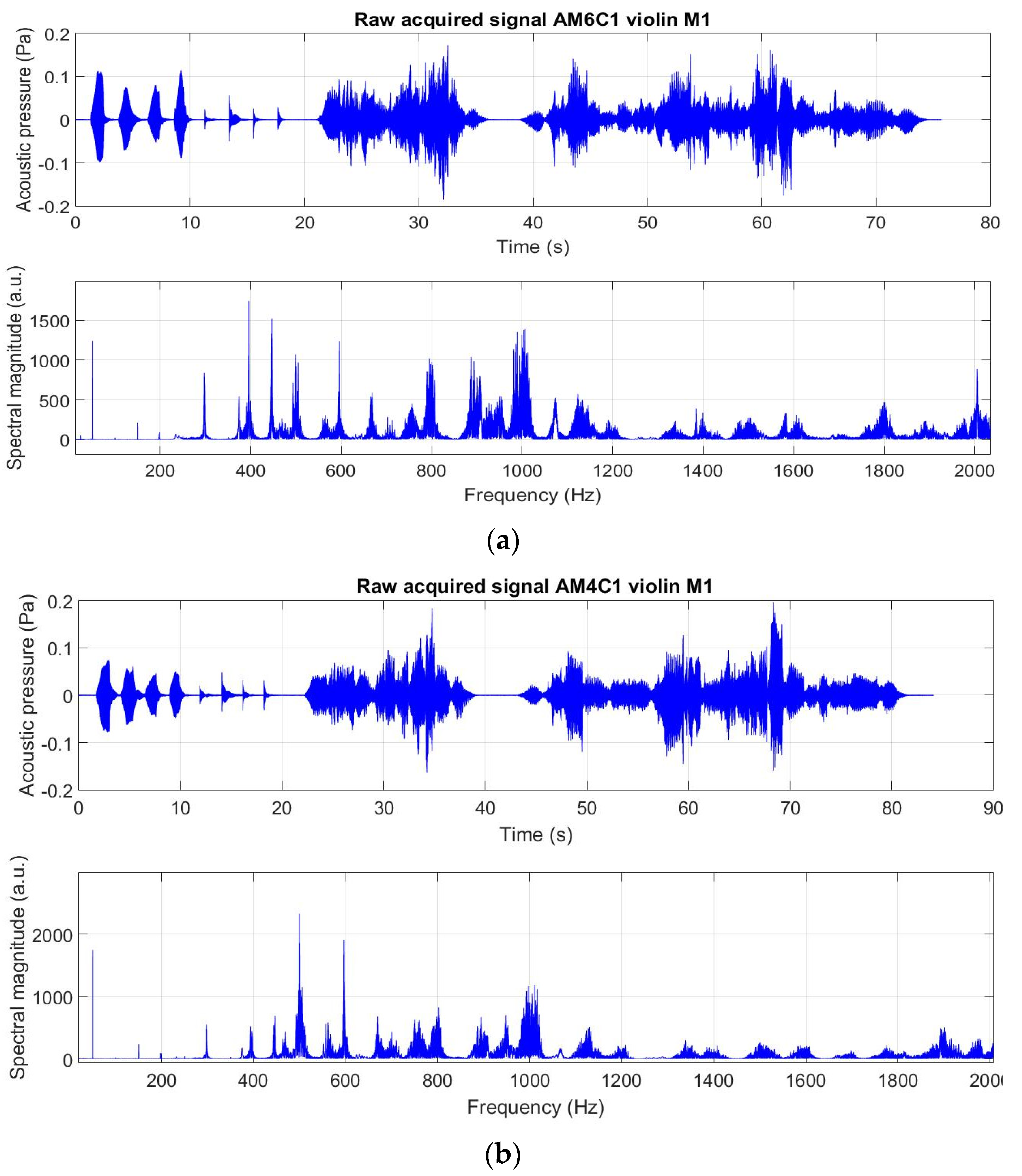
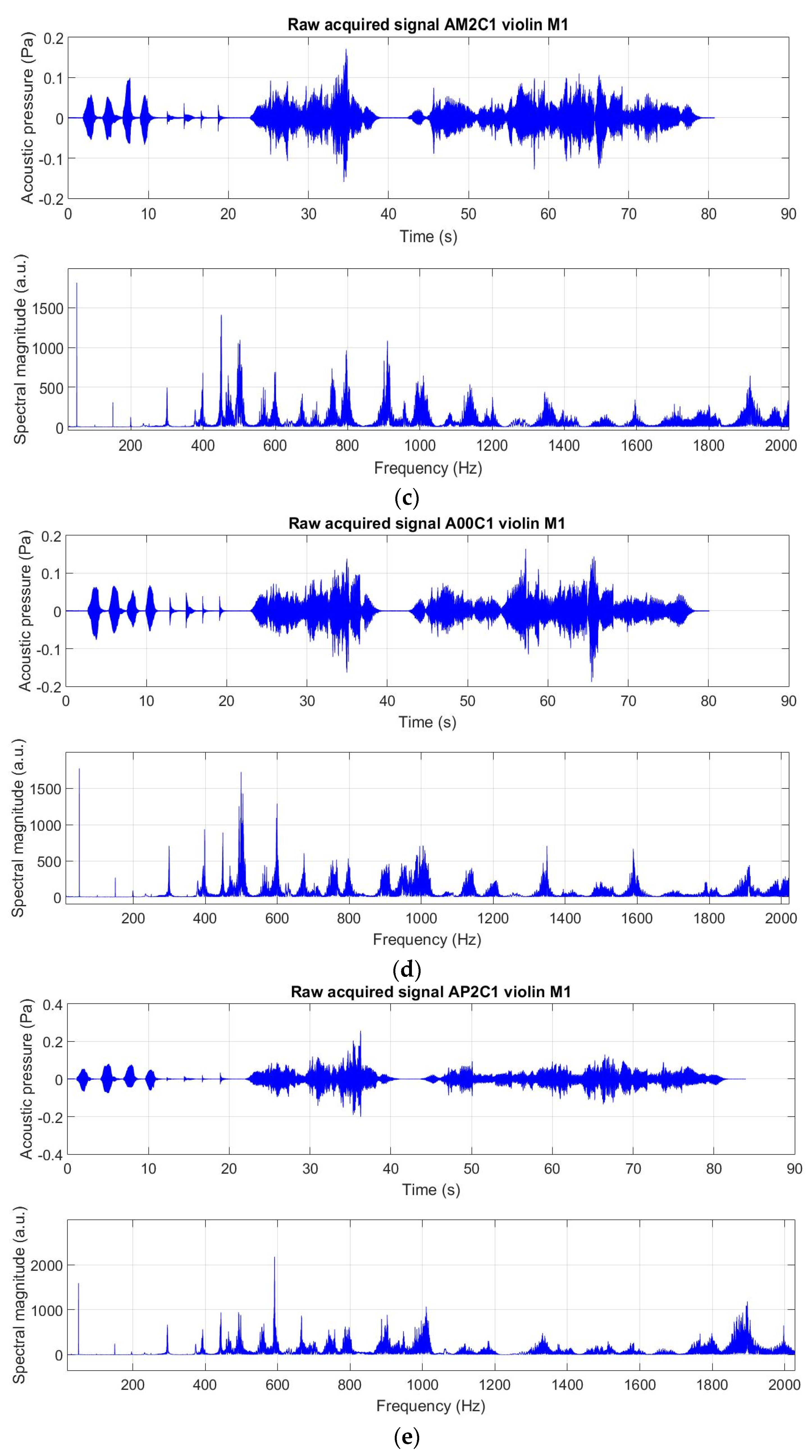



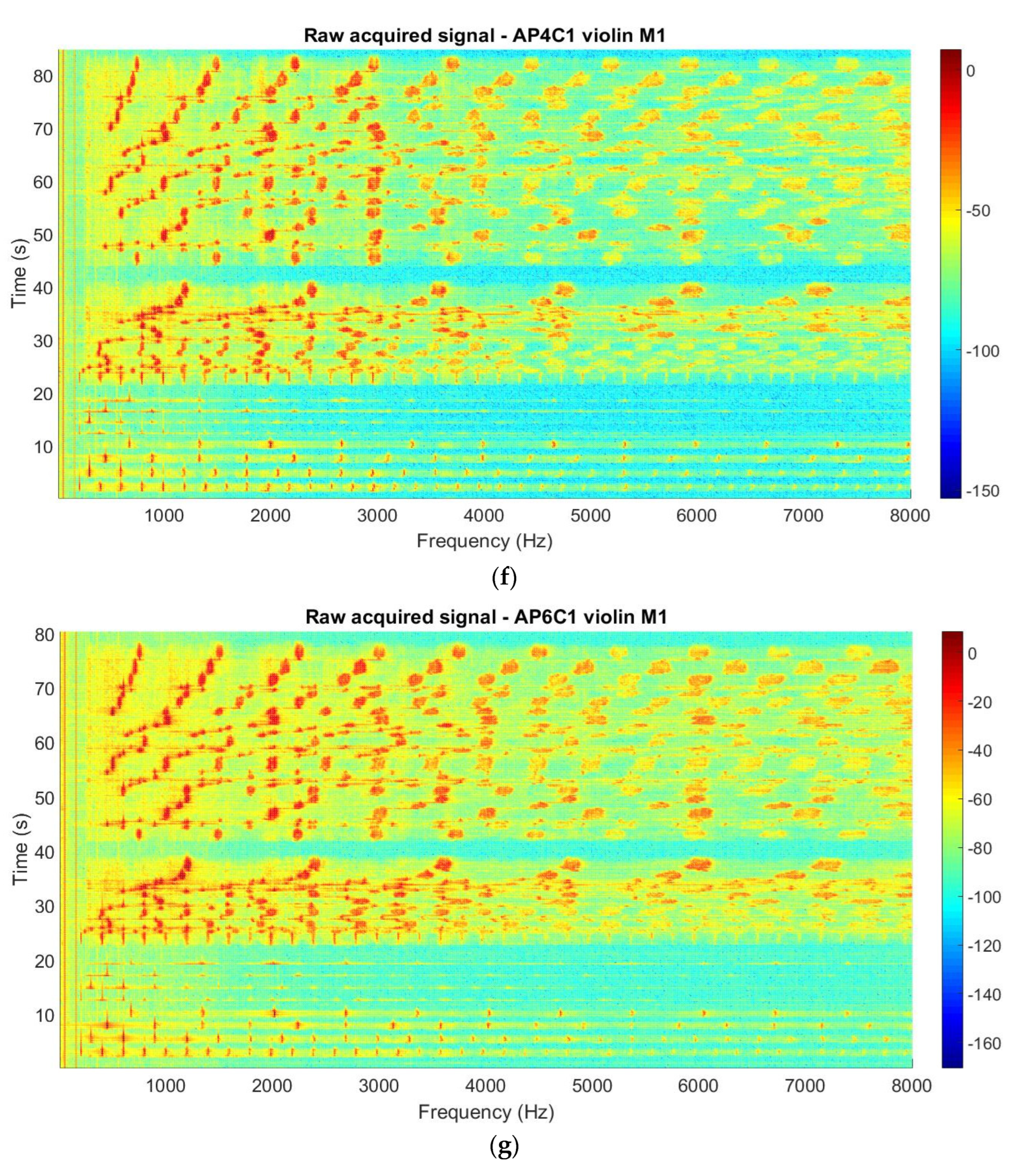


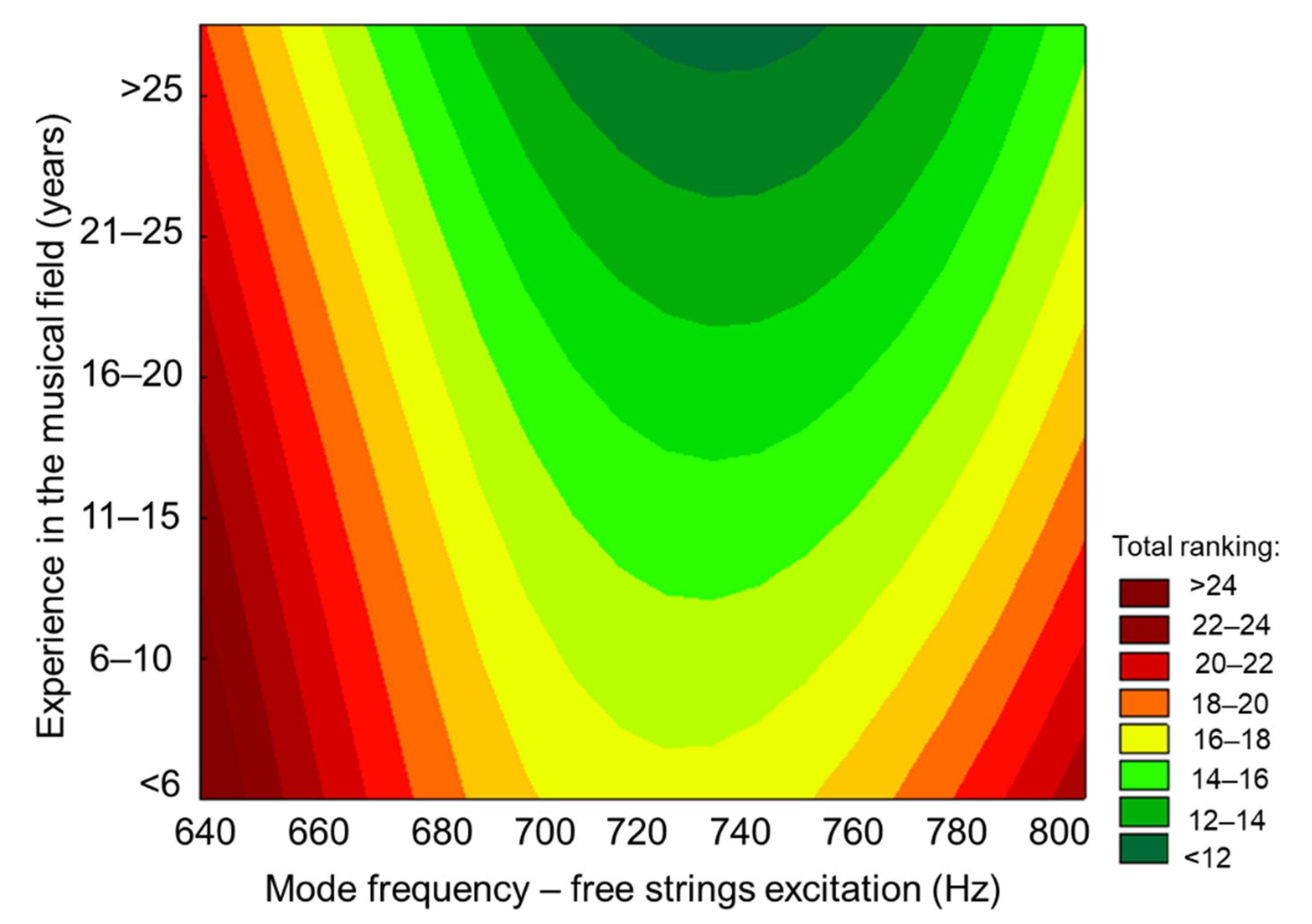
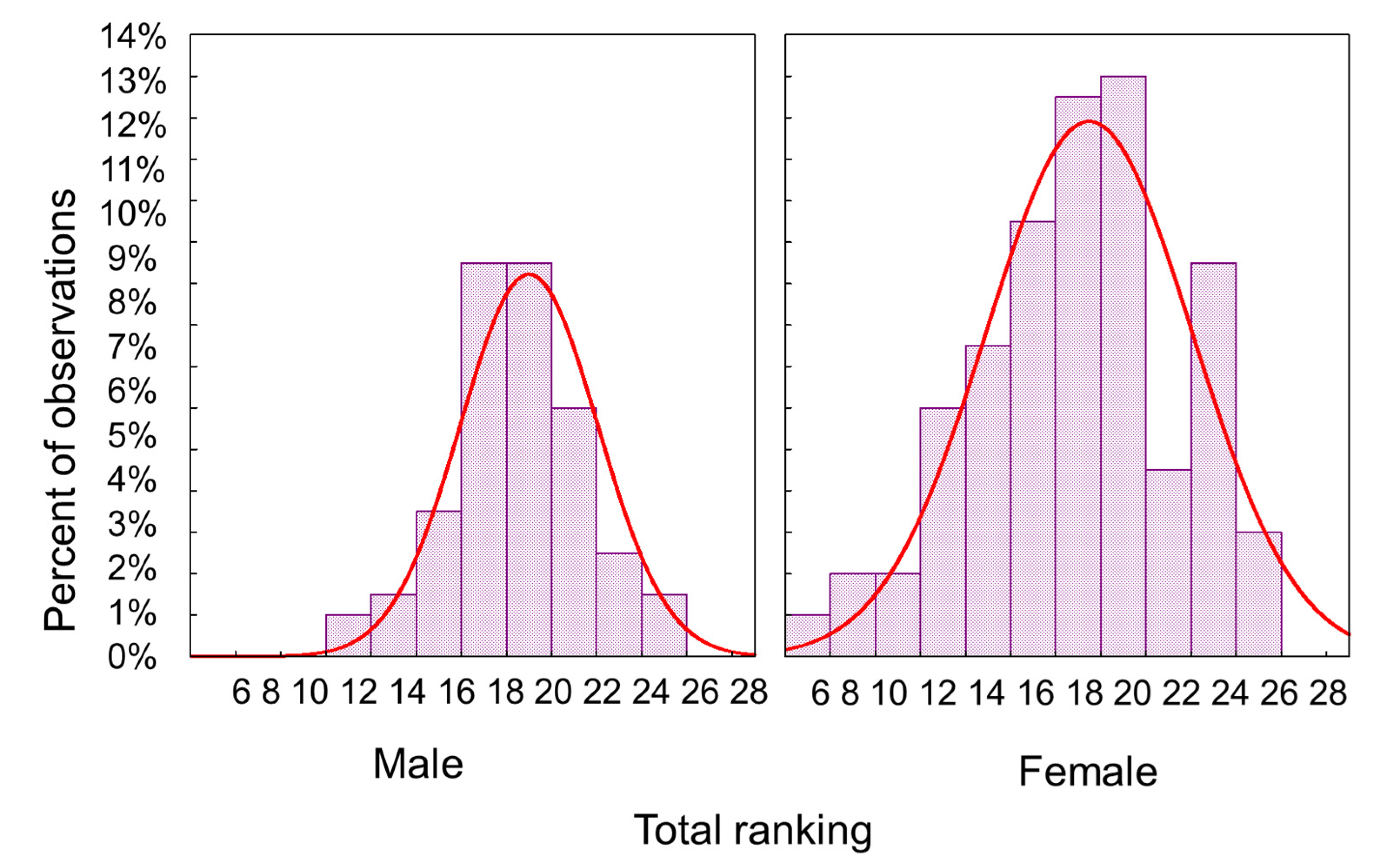
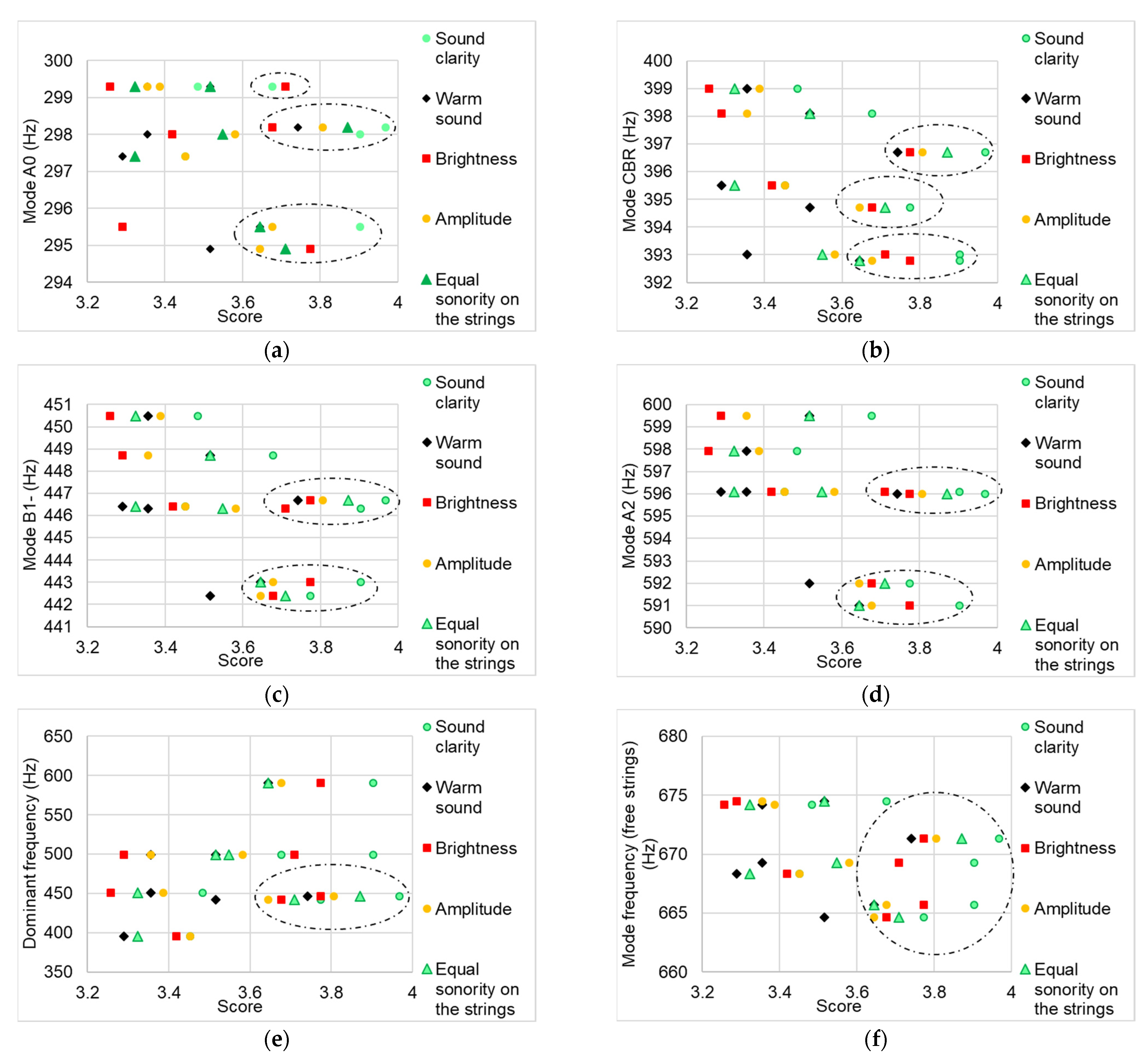

| Tested Violins | |||||||
|---|---|---|---|---|---|---|---|
| Frequency (Hz) | AM6C1 | AM4C1 | AM2C1 | A00C1 | AP2C1 | AP4C1 | AP6C1 |
| Mode A0 | 297.4 | 298 | 299.3 | 299.3 | 295.5 | 294.9 | 298.2 |
| Mode CBR (C2) | 395.5 | 393 | 399.0 | 398.1 | 392.8 | 394.7 | 396.7 |
| Mode B1- | 446.4 | 446.3 | 450.5 | 448.7 | 443.0 | 442.4 | 446.7 |
| Mode A2 | 596.1 | 596.1 | 597.9 | 599.5 | 591.0 | 592.0 | 596 |
| Dominant frequency | 395.5 | 499.4 | 450.5 | 499.4 | 591.0 | 442.4 | 446.7/596 |
| Mode frequency (free strings) | 668.34 | 669.30 | 674.19 | 674.5 | 665.7 | 664.63 | 671.31 |
| Mode frequency (Pizzicato) | 665.13 | 665.86 | 670.81 | 673.2 | 664.9 | 664.40 | 671.45 |
| Mode frequency (musical part) | 1846.20 | 2812.30 | 2360.10 | 2580.3 | 2804.2 | 1875.80 | 1874.30 |
| Tested Violins | |||||||
|---|---|---|---|---|---|---|---|
| Criterion | AM6C | AM4C | AM2C | A00C | AP2C | AP4C | AP6C |
| Sound clarity | 3.452 | 3.903 | 3.484 | 3.677 | 3.903 | 3.774 | 3.968 |
| Sound warmth | 3.290 | 3.355 | 3.355 | 3.516 | 3.645 | 3.516 | 3.742 |
| Brightness | 3.419 | 3.710 | 3.258 | 3.290 | 3.774 | 3.677 | 3.774 |
| Amplitude | 3.452 | 3.581 | 3.387 | 3.355 | 3.677 | 3.645 | 3.806 |
| Equal sonority on the strings | 3.323 | 3.548 | 3.323 | 3.516 | 3.645 | 3.710 | 3.871 |
| Total | 16.936 | 18.097 | 16.807 | 17.354 | 18.644 | 18.322 | 19.161 |
| The position in the respondents’ preferences * | 6 | 4 | 7 | 5 | 2 | 3 | 1 |
| Chronological position in survey | 4 | 3 | 2 | 1 | 6 | 5 | 7 |
| Independent Variables | Wilks’ Lambda | Partial Lambda | F-Remove | p-Level | Tolerance | 1-Tolerance |
|---|---|---|---|---|---|---|
| Violin type | 0.787 | 0.974 | 1.380 | 0.242 | 0.350 | 0.650 |
| Mode frequency—free string excitation | 0.771 | 0.994 | 0.336 | 0.854 | 0.469 | 0.531 |
| Mode frequency—Pizzicato excitation | 0.784 | 0.977 | 1.212 | 0.307 | 0.547 | 0.453 |
| Mode frequency—musical part | 0.778 | 0.985 | 0.792 | 0.532 | 0.338 | 0.662 |
| Age | 0.774 | 0.990 | 0.536 | 0.709 | 0.409 | 0.591 |
| Experience | 0.810 | 0.946 | 2.911 | 0.023 | 0.410 | 0.590 |
| Gender | 0.814 | 0.941 | 3.209 | 0.014 | 0.978 | 0.022 |
| Independent Variables | Wilks’ Lambda | Partial Lambda | F-Remove | p-Level | Tolerance | 1-Tolerance |
|---|---|---|---|---|---|---|
| Violin type | 0.812 | 0.976 | 1.287 | 0.276 | 0.347 | 0.653 |
| Mode frequency—free string excitation | 0.814 | 0.974 | 1.398 | 0.236 | 0.460 | 0.540 |
| Mode frequency—Pizzicato excitation | 0.821 | 0.966 | 1.817 | 0.127 | 0.535 | 0.465 |
| Mode frequency—musical part | 0.799 | 0.993 | 0.379 | 0.823 | 0.340 | 0.660 |
| Age | 0.818 | 0.969 | 1.651 | 0.163 | 0.384 | 0.616 |
| Experience | 0.867 | 0.915 | 4.807 | 0.001 | 0.385 | 0.615 |
| Gender | 0.823 | 0.963 | 1.995 | 0.097 | 0.987 | 0.013 |
| Independent Variables | Wilks’ Lambda | Partial Lambda | F-Remove | p-Level | Tolerance | 1-Tolerance |
|---|---|---|---|---|---|---|
| Violin type | 0.784 | 0.969 | 1.656 | 0.162 | 0.355 | 0.645 |
| Mode frequency—free string excitation | 0.774 | 0.981 | 0.987 | 0.415 | 0.455 | 0.545 |
| Mode frequency—Pizzicato excitation | 0.771 | 0.986 | 0.757 | 0.554 | 0.552 | 0.448 |
| Mode frequency—musical part | 0.785 | 0.969 | 1.668 | 0.159 | 0.334 | 0.666 |
| Age | 0.763 | 0.996 | 0.205 | 0.936 | 0.404 | 0.596 |
| Experience | 0.805 | 0.944 | 3.043 | 0.018 | 0.404 | 0.596 |
| Gender | 0.816 | 0.932 | 3.774 | 0.006 | 0.974 | 0.026 |
| Independent Variables | Wilks’ Lambda | Partial Lambda | F-Remove | p-Level | Tolerance | 1-Tolerance |
|---|---|---|---|---|---|---|
| Violin type | 0.757 | 0.968 | 1.676 | 0.157 | 0.349 | 0.651 |
| Mode frequency—free string excitation | 0.772 | 0.949 | 2.744 | 0.030 | 0.448 | 0.552 |
| Mode frequency—Pizzicato excitation | 0.755 | 0.972 | 1.498 | 0.204 | 0.546 | 0.454 |
| Mode frequency—musical part | 0.758 | 0.967 | 1.773 | 0.136 | 0.333 | 0.667 |
| Age | 0.737 | 0.995 | 0.268 | 0.898 | 0.402 | 0.598 |
| Experience | 0.787 | 0.931 | 3.811 | 0.005 | 0.403 | 0.597 |
| Gender | 0.784 | 0.936 | 3.544 | 0.008 | 0.977 | 0.023 |
| Independent Variables | Wilks’ Lambda | Partial Lambda | F-Remove | p-Level | Tolerance | 1-Tolerance |
|---|---|---|---|---|---|---|
| Violin type | 0.721 | 0.972 | 1.484 | 0.208 | 0.350 | 0.650 |
| Mode frequency—free string excitation | 0.730 | 0.960 | 2.151 | 0.076 | 0.455 | 0.545 |
| Mode frequency—Pizzicato excitation | 0.707 | 0.991 | 0.473 | 0.755 | 0.545 | 0.455 |
| Mode frequency—musical part | 0.724 | 0.969 | 1.673 | 0.158 | 0.333 | 0.667 |
| Age | 0.715 | 0.980 | 1.028 | 0.394 | 0.411 | 0.589 |
| Experience | 0.784 | 0.894 | 6.085 | 0.000 | 0.411 | 0.589 |
| Gender | 0.745 | 0.940 | 3.267 | 0.013 | 0.977 | 0.023 |
Publisher’s Note: MDPI stays neutral with regard to jurisdictional claims in published maps and institutional affiliations. |
© 2022 by the authors. Licensee MDPI, Basel, Switzerland. This article is an open access article distributed under the terms and conditions of the Creative Commons Attribution (CC BY) license (https://creativecommons.org/licenses/by/4.0/).
Share and Cite
Nastac, S.M.; Gliga, V.G.; Mihalcica, M.; Nauncef, A.M.; Dinulica, F.; Campean, M. Correlation between Acoustic Analysis and Psycho-Acoustic Evaluation of Violins. Appl. Sci. 2022, 12, 8620. https://doi.org/10.3390/app12178620
Nastac SM, Gliga VG, Mihalcica M, Nauncef AM, Dinulica F, Campean M. Correlation between Acoustic Analysis and Psycho-Acoustic Evaluation of Violins. Applied Sciences. 2022; 12(17):8620. https://doi.org/10.3390/app12178620
Chicago/Turabian StyleNastac, Silviu Marian, Vasile Ghiorghe Gliga, Mircea Mihalcica, Alina Maria Nauncef, Florin Dinulica, and Mihaela Campean. 2022. "Correlation between Acoustic Analysis and Psycho-Acoustic Evaluation of Violins" Applied Sciences 12, no. 17: 8620. https://doi.org/10.3390/app12178620
APA StyleNastac, S. M., Gliga, V. G., Mihalcica, M., Nauncef, A. M., Dinulica, F., & Campean, M. (2022). Correlation between Acoustic Analysis and Psycho-Acoustic Evaluation of Violins. Applied Sciences, 12(17), 8620. https://doi.org/10.3390/app12178620








